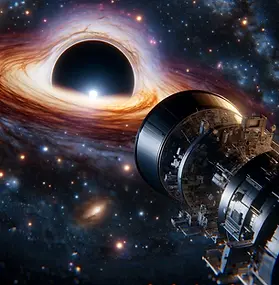Resolving Physics' Greatest Mysteries
A Chunk-Based Interpretation of Thermocouple Behavior Using the Timothian Model
Thermocouples generate current from temperature differences. How can a thermocouple, such a simple combination of metals, translate thermal energy into electrical energy so effectively?
The junction where the metals are welded together acts as a rectifier of ambient freely moving chunks. The random jostling is organized by the mechanical rectification enough to create chunk flow and counterflow as described by this model in The Nature of Magnetism, but without generating spin of the chunks.
The Unification of Fundamental Forces
How can we reconcile the four fundamental forces (gravity, electromagnetism, strong nuclear, and weak nuclear) into a single, coherent framework? Why have attempts at unification been unsuccessful so far?
The Timothian Model unifies all fundamental forces as emergent properties of chunk interactions within the ubiquitous chunk medium, eliminating the need for separate force carriers or extra dimensions.
Strong Force as Localized Gravity
Why is the strong nuclear force so powerful at short ranges but ineffective at larger scales? How does it overcome electromagnetic repulsion in nuclei?
The strong force emerges from intense local chunk displacement by atomic seeds, creating powerful stratification tensions analogous to gravity at subatomic scales.
The Strong Nuclear Force
Why is the strong force so powerful at short ranges but ineffective at larger scales?
An atom's local displacement of the medium encounters an equal and opposite restoration force from the local medium. The displacement and restoration tension is more diffuse with distance and growing volume.
Quantum Field Theory and Virtual Particles
What is the physical reality of quantum fields and virtual particles?
Varying density pieces of subatomic matter are ubiquitous throughout the universe. Gravitational fields are medium stratifications, magnetic fields are local medium flows, and larger masses are aggregate combinations of the medium's constituents.
Matter and the Matter-Antimatter Asymmetry
Why is there so much more matter than antimatter in the observable universe? What is the fundamental nature of matter?
There is no 'antimatter'. Subatomic pieces of matter constitute the matter of the medium. They can aggregate to form atomic matter - and disaggregate back to move freely as part of the medium.
The Speed of Gravity
How can gravity act seemingly instantaneously across the solar system to maintain stable orbits?
Gravity is the equal and opposite reaction to medium displacement by atoms. Bodies bidirectionally interact with the medium, both changing medium stratifications for all local bodies and moving toward their own buoyant point in the medium.
The Michelson-Morley Experiment
Why didn't the experiment detect the Earth's motion through space? How does light propagate without a medium?
The medium is non-uniform, non-stationary, and interacts directly with larger masses. The Sun rotates the medium which rotates the Earth, so the Earth and Medium are in synchronous movement. Light requires a medium.
Weak Force as Pressure-Driven Particle Decay
What drives radioactive decay? Why do some particles decay quickly while others are stable for billions of years?
The weak force manifests as pressure-driven particle decay, where chunk configurations change due to imbalances between internal atomic structures and external medium pressures.
The Right Hand Rule
What is the mechanical relationship between the curvature of a coil and the direction of current through a coil create the effects of the right-hand rule?
Different species of the medium have different densities, and when they "roll" through the coil, they develop spin dependent upon the direction of roll.
The Nature of Vacuum Energy
Why is the vacuum energy so much smaller than quantum field theory predicts? What is the true nature of "empty" space?
Anywhere atoms don't exist, the medium's subatomic constintuents do. The medium constantly shifts, flows, oscillates, stratifies, aggregates, and disaggregates, constituting the baseline energy of the medium.
The Hall Effect
What is the physical mechanism behind this transverse voltage? How does the magnetic field interact with the current?
Subatomic pieces of matter flow in the magnetic field and in the conductor. Magnetically driven pieces physically spin as they exit the magnet, and transfer kinetic energy to the electrically driven pieces.
Magnetism as Organized Chunk Flows
What is the physical nature of magnetic fields? How do permanent magnets maintain their fields indefinitely?
Magnetism arises from pressure-driven flows and counterflows of chunks, with permanent magnets rectifying ambient chunk motions into structured, rotating flows.




























